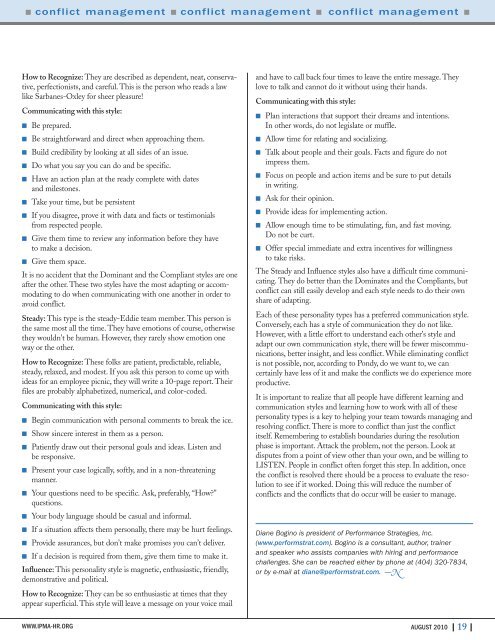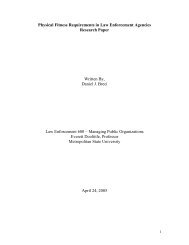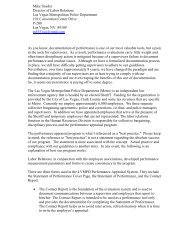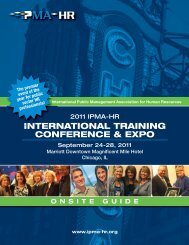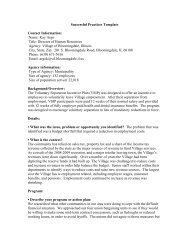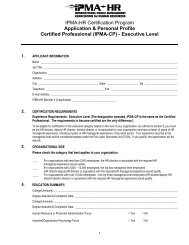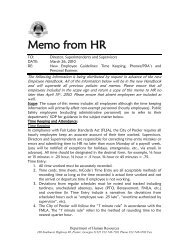Conflict Management Coaching - IPMA
Conflict Management Coaching - IPMA
Conflict Management Coaching - IPMA
You also want an ePaper? Increase the reach of your titles
YUMPU automatically turns print PDFs into web optimized ePapers that Google loves.
■ conflict management ■ conflict management ■ conflict management ■<br />
How to Recognize: They are described as dependent, neat, conservative,<br />
perfectionists, and careful. This is the person who reads a law<br />
like Sarbanes-Oxley for sheer pleasure!<br />
Communicating with this style:<br />
■ Be prepared.<br />
■ Be straightforward and direct when approaching them.<br />
■ Build credibility by looking at all sides of an issue.<br />
■ Do what you say you can do and be specific.<br />
■ Have an action plan at the ready complete with dates<br />
and milestones.<br />
■ Take your time, but be persistent<br />
■ If you disagree, prove it with data and facts or testimonials<br />
from respected people.<br />
■ Give them time to review any information before they have<br />
to make a decision.<br />
■ Give them space.<br />
It is no accident that the Dominant and the Compliant styles are one<br />
after the other. These two styles have the most adapting or accommodating<br />
to do when communicating with one another in order to<br />
avoid conflict.<br />
Steady: This type is the steady-Eddie team member. This person is<br />
the same most all the time. They have emotions of course, otherwise<br />
they wouldn’t be human. However, they rarely show emotion one<br />
way or the other.<br />
How to Recognize: These folks are patient, predictable, reliable,<br />
steady, relaxed, and modest. If you ask this person to come up with<br />
ideas for an employee picnic, they will write a 10-page report. Their<br />
files are probably alphabetized, numerical, and color-coded.<br />
Communicating with this style:<br />
■ Begin communication with personal comments to break the ice.<br />
■ Show sincere interest in them as a person.<br />
■ Patiently draw out their personal goals and ideas. Listen and<br />
be responsive.<br />
■ Present your case logically, softly, and in a non-threatening<br />
manner.<br />
■ Your questions need to be specific. Ask, preferably, “How?”<br />
questions.<br />
■ Your body language should be casual and informal.<br />
■ If a situation affects them personally, there may be hurt feelings.<br />
■ Provide assurances, but don’t make promises you can’t deliver.<br />
■ If a decision is required from them, give them time to make it.<br />
Influence: This personality style is magnetic, enthusiastic, friendly,<br />
demonstrative and political.<br />
How to Recognize: They can be so enthusiastic at times that they<br />
appear superficial. This style will leave a message on your voice mail<br />
and have to call back four times to leave the entire message. They<br />
love to talk and cannot do it without using their hands.<br />
Communicating with this style:<br />
■ Plan interactions that support their dreams and intentions.<br />
In other words, do not legislate or muffle.<br />
■ Allow time for relating and socializing.<br />
■ Talk about people and their goals. Facts and figure do not<br />
impress them.<br />
■ Focus on people and action items and be sure to put details<br />
in writing.<br />
■ Ask for their opinion.<br />
■ Provide ideas for implementing action.<br />
■ Allow enough time to be stimulating, fun, and fast moving.<br />
Do not be curt.<br />
■ Offer special immediate and extra incentives for willingness<br />
to take risks.<br />
The Steady and Influence styles also have a difficult time communicating.<br />
They do better than the Dominates and the Compliants, but<br />
conflict can still easily develop and each style needs to do their own<br />
share of adapting.<br />
Each of these personality types has a preferred communication style.<br />
Conversely, each has a style of communication they do not like.<br />
However, with a little effort to understand each other’s style and<br />
adapt our own communication style, there will be fewer miscommunications,<br />
better insight, and less conflict. While eliminating conflict<br />
is not possible, nor, according to Pondy, do we want to, we can<br />
certainly have less of it and make the conflicts we do experience more<br />
productive.<br />
It is important to realize that all people have different learning and<br />
communication styles and learning how to work with all of these<br />
personality types is a key to helping your team towards managing and<br />
resolving conflict. There is more to conflict than just the conflict<br />
itself. Remembering to establish boundaries during the resolution<br />
phase is important. Attack the problem, not the person. Look at<br />
disputes from a point of view other than your own, and be willing to<br />
LISTEN. People in conflict often forget this step. In addition, once<br />
the conflict is resolved there should be a process to evaluate the resolution<br />
to see if it worked. Doing this will reduce the number of<br />
conflicts and the conflicts that do occur will be easier to manage.<br />
Diane Bogino is president of Performance Strategies, Inc.<br />
(www.performstrat.com). Bogino is a consultant, author, trainer<br />
and speaker who assists companies with hiring and performance<br />
challenges. She can be reached either by phone at (404) 320-7834,<br />
or by e-mail at diane@performstrat.com. —N<br />
WWW.<strong>IPMA</strong>-HR.ORG AUGUST 2010 | 19 |


